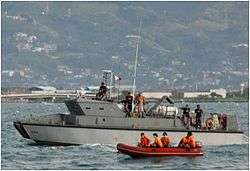Multi-purpose Attack Craft
 | |
| Class overview | |
|---|---|
| Name: | MPAC (Multi-Purpose Attack Craft) |
| Builders: | Lung Teh Shipbuilding Co. Ltd., Propmech Corp. |
| Operators: | Philippine Navy |
| In commission: |
|
| Building: | 3 |
| Planned: | 9 |
| Completed: | 6 |
| Active: | 6 |
| General characteristics | |
| Length: |
|
| Beam: | 4.76 m |
| Draft: |
|
| Depth: | 2.1 m |
| Speed: |
|
| Complement: | 3 crew, 2 officers, 16 fully equipped amphibious troops |
| Armament: |
|
Multi-Purpose Attack Craft (MPAC) is a class of fast landing craft developed for the Philippine Navy. It is designed to transport troops at a high speed and then land them on the beach.
Construction
The MPAC's hull is made out of aluminum and is powered by water jet engines. It has a range of 560 km, maximum speed of 40-45 knots and carries a crew of 5 plus 16 fully equipped soldiers.[1]
History
In 2009, the Philippine Navy ordered the first batch of three ships from a Taiwanese company whose identity was never revealed up to now. However, speculations point out that the manufacturer might be the Taiwanese company "Lung Teh Shipbuilding Co. Ltd."
In 2011, an additional three MPACs were built that were slightly bigger than the previous three ships, and these ships this time were built by the Filipino company "Propmech Corp."
In 2016, Propmech was again contracted to build another three ships for USD 1.85 million (PHP 89.7 million) each. Delivery for all three ships is set for 2017.[2]
Service History
In May 2010, the MPACs got their first baptism of fire when they were used to used to extract Precinct Count Optical Scan (PCOS) machines in Basilan under heavy mortar fire from rouge Moro Islamic Liberation Front (MILF) rebels attempting to sabotage the election.[3]
In September 2013, the MPACs led the search and rescue operations for the passengers of the ill-fated MV St. Thomas Aquinas owned by the 2GO Shipping Company. It collided with M/V Sulpicio Express Siete in Cebu resulting in more than 100 casualties.[3]
In the same month of September 2013 during the "Zamboanga City Crisis", four MPACs were among those used to to patrol the coastal villages of Zamboanga City and prevent the sympathizers of the Moro National Liberation Front (MNLF) in Basilan and Sulu from reinforcing their troops in Zamboanga.[4]
In September 2015, an MPAC participated in the 2015 PAGSISIKAP Fleet-Marine Amphibious Exercise in Ternate, Cavite by landing Philippine Marine Corps personnel into the beach.[5]
In March 2016, two MPACs of the Naval Forces Western Mindanao (NAVFORWESM) were used to intercept the M/L Fatima Radz-Auna off the coast of Arena Blanco, Zamboanga. The Radz-Auna was found with 1,500 5 kg sacks of smuggled Sugar with an estimated worth of PHP 3.15 million, and was immediately escorted to the Zamboanga Port and turned over to the Bureau of Customs.[6]
Versions
- Mk1
- Original production version with total of three built by Lung Teh Shipbuiling Co.[7]
- Mk2
- Next production version with another three built by Propmech Corp. This version is 2 m longer than the Mk1 and is differentiated by the different shape of its Pilot House and the location of the 3 machine guns.[8]
- Mk3
- Latest production build able to operate up to Sea State 5.[9] armed with Spike ER[2] missiles, a Mini-Typhoon[10] Remote Weapons Station (RWS) with a 12.7 mm Machine Gun and two 7.62 mm Machine Guns slated for delivery in 2017.
See also
References
- ↑ "MPACs to be transformed into 'harassment force'"
- 1 2 "ADAS 2016: Propmech building missile attack craft"
- 1 2 "Philippine Navy's Multi-Purpose Attack Craft or MPAC led the rescue efforts in Cebu"
- ↑ "7 ships, elite teams form Zambo naval blockade"
- ↑ "Navy kicks off 5-day drill in Ternate, Cavite"
- ↑ "Military intercepts smuggled sugar shipment off Zamboanga"
- ↑ "15M Multi-Purpose Attack Craft Mk1"
- ↑ "17M MULTI-PURPOSE ATTACK CRAFT Mk2"
- ↑ "Invitation to Bid for MPAC Mk3
- ↑ "Israeli Missiles, RWS to Equip Philippine Navy Combat Boats". Defense Update. February 27, 2016. Retrieved February 27, 2016.